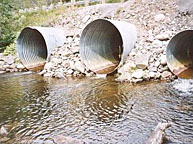Small changes, large consequences
Small changes, large consequences McGill University
User Tools (skip):
Small changes, large consequences
Those who do not learn from history are doomed to repeat it. Ignoring the lessons learnt from the collapse of salmon fisheries in the Pacific Northwest could endanger the native fishes of Quebec and destroy our fragile aquatic ecosystems.
 |
|
The story of the once mighty Pacific salmon is precautionary. They are anadromous fish, which means they can survive in both salt and fresh water. Salmon spend much of their life in the ocean, but return to the freshwater streams of their birth to reproduce -- an epic migration of up to 1000 km. But intensive hydroelectric dam construction over the past 50 years altered salmon rivers, blocked spawning runs and decimated their numbers.
McGill biology professor Joe Rasmussen and PhD student Genevieve Morinville have discovered that small-scale dam construction in Quebec could be just as damaging to the environment as their larger counterparts out West. "We are beginning to realize that the salmon story is the same on all spatial scales," said Rasmussen, who has been studying the effects of ecosystem disturbance for the past decade.
In Quebec, many fish species spawn in tributary streams. Sea trout, one of Quebec's anadromous species, travel from the St. Lawrence and Saguenay river estuaries in the East; a migration comparable to the larger-scale migrations of salmon in the Pacific Northwest. Streams offer the best conditions for incubating fish eggs -- ideal temperatures, clean water and well-oxygenated gravel sediments. Streams also contain fewer predators than large rivers, lakes and estuaries, providing fish with a safe environment to mature in.
"Basically, anything that has the effect of blocking fish movement to these spawning and nursery grounds can be considered a dam," explained Rasmussen. In Quebec, poorly designed culverts are the culprits. Culverts are conduits or drains used to direct water beneath roads and railways. The increased water velocity and elevated outflow of these "mini-dams" can obstruct the migration of fish to tributary streams.
It is complicated to predict how an ecosystem might react to an environmental disturbance such as culvert construction. An ecosystem is a fragile house-of-cards, consisting of many different organisms, each with a unique community role. "We will end up losing biodiversity," warned Rasmussen. "Nature is a library and we're throwing away the books."
In some situations, it is not an entire species that is at risk from local extinction, but a specific form of that species. Morinville is investigating the effect of culvert construction on different trout forms. "Brook trout and sea trout are the same species -- Salvelinus fontinalis," she said. Sea trout is the migratory form and brook trout is the non-migratory, or resident form. "Both forms spawn in tributary streams," Morinville explained. "But it's the migratory sea trout that is at risk from poor culvert construction." The brook trout spend their entire life in the spawning and nursery areas. Sea trout travel downstream, passing through the culverts that block their return spawning migration.
The impact of a single culvert on the aquatic life of Quebec may be smaller than that of a large hydroelectric dam; however, the number in which roads and railways, and hence culverts, are being constructed in the St. Lawrence River Valley amplifies the effect. Each one of the thousands of culverts in Quebec has the potential to cut fish off from their natural spawning and nursery grounds. "It's like death by a thousand insults," cautioned Rasmussen. Where culverts block migration to spawning streams, sea trout are forced to spawn elsewhere. Even if a suitable habitat can be found for egg incubation, vulnerable young fish soon become part of a sushi smorgasbord for fish-eating birds like kingfishers and mergansers, and for predatory fish like bass and pike. The effect on Quebec's sport fishing industry could be ruinous. "Sport fishing is big business, attracting locals and tourists alike," said Morinville. "Sea trout are being increasingly sought after by sport fishers because of declines in Atlantic salmon.
Yet there is light at the end of the culvert. Environmental research out west is working towards the creation of a landscape model for salmon management. The model, used by resource managers, contains the biological information necessary to ensure that further habitat alteration is environmentally responsible. Rasmussen and Morinville hope to develop similar models for the organisms threatened by culvert construction in Quebec. Finding ways to minimize the impact of habitat alteration on the environment is paramount, because an ounce of prevention is priceless when there is no cure.
McGill's SPARK program (Students Promoting Awareness of Research Knowledge) is funded by NSERC and run by the Faculty of Education, VP Research Office, and the University Relations Office.

